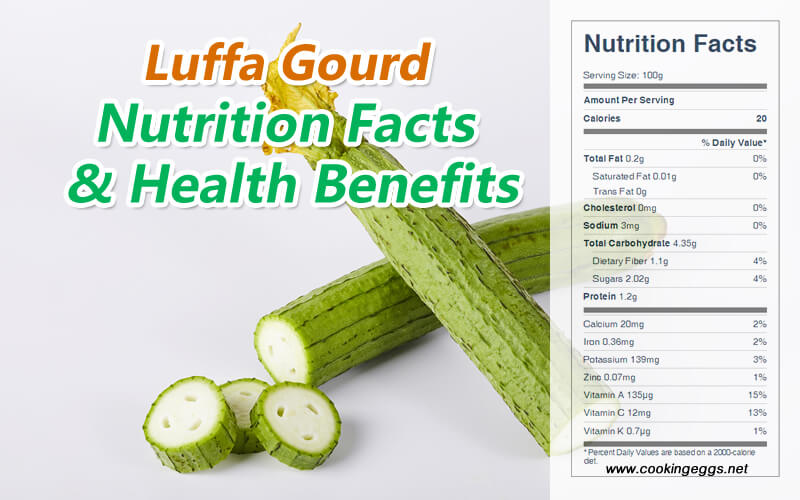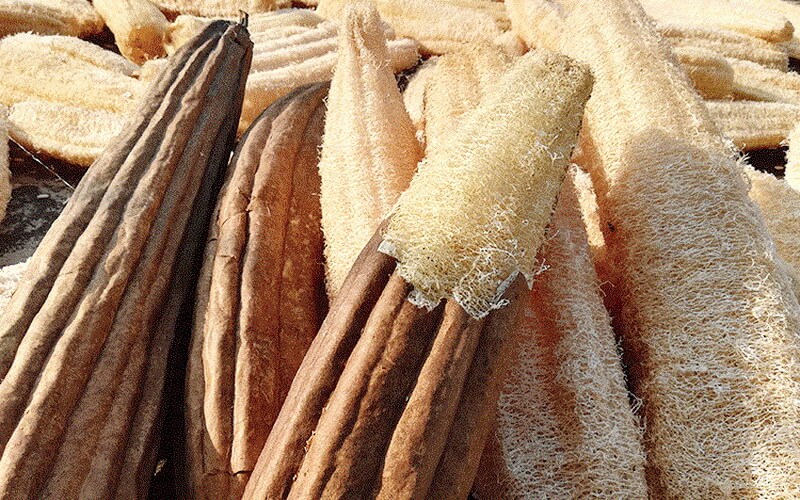Luffa Gourd Nutrition Facts and Health Benefits
Luffa gourd usually refers to the fruits of the species Luffa aegyptiaca and Luffa acutangula. Luffa is also known as Chinese okra in Canada and America. It is a vine plant cultivated for its fruit and is native to South and Southeast Asia. The luffa fruit has many names, including the loofah, washrag gourd, running okra, dishcloth gourd, sponge gourd, and more.
Luffa is a member of the cucurbitacae family, the luffa gourd is closely related to the cucumber. The young fruits of luffa are used as cooked vegetables or eaten raw, their taste is almost similar to zucchini, and the shoots and flowers are sometimes also used. The fully ripened fruit is strongly fibrous and inedible, and is used to make scrubbing bath sponges. Due to its use as a scrubbing sponge, it is also known by the common names dishrag gourd, rag gourd, sponge gourd, and vegetable-sponge.
There are 3 species of luffa gourd:
Luffa acutangula - also called angled luffa, Chinese okra, dish cloth gourd, ridged luffa, ridge gourd, sponge gourd, vegetable gourd, strainer vine, ribbed loofah, silky gourd, silk gourd, and sinkwa towelsponge
Luffa aegyptiaca/Luffa cylindrica - also called Egyptian cucumber, Vietnamese luffa, dishrag gourd, rag gourd, sponge gourd, vegetable-sponge, smooth luffa, Egyptian luffa, dishrag gourd, gourd loofa
Luffa operculata - also called wild loofa, sponge cucumber
Nutritional Value of Luffa gourd
Chinese okra contain dietary fiber, vitamin A, vitamin C, and essential minerals like zinc, magnesium, riboflavin, and zinc.
Raw luffa gourd is low in calories; it is 93% water, 4.3% carbohydrates, 1% protein, and contains negligible fat. In a 100-gram reference amount, towelgourd supplies 20 calories, 4.35 g carbohydrate, 1.2 g protein, 0.2 g fat, 410 IU vitamin A, 12 mg vitamin C, 20 mg calcium, 0.36 mg iron, 14 mg magnesium, 139 mg potassium, and 0.07 mg zinc.

Raw Luffa Gourd Nutrition Facts Label
Main Health Benefits of Luffa Gourd
1. Protects Skin
Luffa gourd is a good source of vitamin C (ascorbic acid), providing about 12 mg per 100 g. Vitamin C is an essential nutrient involved in the repair of tissue, the formation of collagen, and the enzymatic production of certain neurotransmitters. The study shows that a high intake of Vitamin C can reduce skin dryness, wrinkles, and slow down the aging process.
2. Eye Health
Macular degeneration is an eye problem that could lead to blindness, it is the number-one cause of blindness in elderly adults. Vitamin A in luffa gourd is useful for preventing eye problems. In addition, Vitamin A is important for the immune system because it is needed for the differentiation of cells into the various types of immune cells.
3. Help Prevent Diabetes
Dietary fiber intake provides many health benefits, such as in diabetes, obesity, and cancer. Luffa gourd has a high fiber content and is low in fat. It can regulate blood sugar, which may reduce glucose and insulin levels in diabetic patients and may lower the risk of diabetes.
4. Lowering Blood Pressure
Luffa gourd contain a considerable amount of potassium, which is extremely beneficial for healthy blood pressure levels. Potassium acts as a vasodilator, which means it helps to relax blood vessels, reduces the strain on the cardiovascular system, and encourages circulation and oxygenation to vital parts of the body. Studies show that foods rich in potassium help lower blood pressure and reduce the risk of stroke and cardiovascular disease.
5. Used in Traditional Medicine
The leaves of luffa are used to treat swellings and intestinal worms.
The fruit of luffa is also used to treat headaches, skin problems, and to expel intestinal parasites.

Other Uses of Luffa
In addition to consumption, fully ripe and dried-out smooth sponge gourds are popularly used to make bath sponges, exfoliating sponges, pot scrubbers, filters, packing material, and crafts. The mature Luffa fruits are harvested when dry and processed to remove all but the fruit fibre, which can then be used as a sponge or as fibre for making hats.
The largest market for luffa is the cosmetic industry, which uses luffa in various bath and cosmetic products.
In Japan, in regions other than the Ryukyu Islands and Kyushu, it is predominantly grown for use as a sponge or for applying soap, shampoo, and lotion.